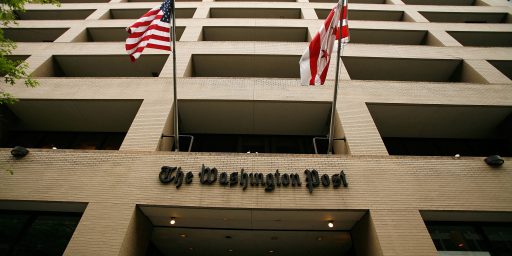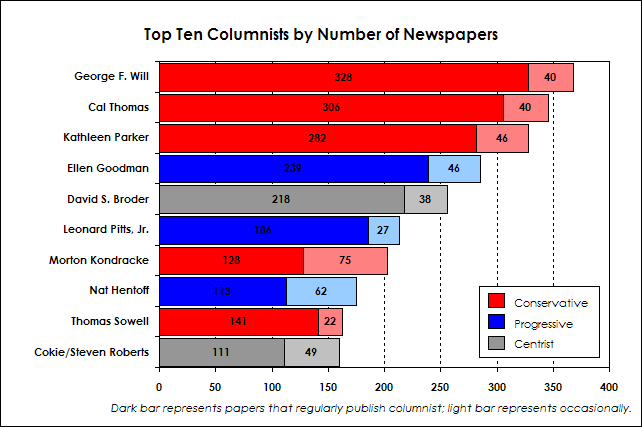The Latest Word on Media Bias
Two University of Chicago economists have taken a new tack at measuring media bias and come to two conclusions that are doubtless shocking: first that media bias exists, and second it can be attributed to telling readers what they want to hear:
[The authors] showed that the main driver of any slant was the newspaper’s audience, not bias by the newspaper’s owner.
A comparison of circulation data (per capita) to the ratio of Republican to Democratic campaign contributions by ZIP code showed that circulation was strongly related to whether the newspaper matched the readers’ own ideology.
Their measure indicates that The Los Angeles Times, for example, is a liberal paper. Its circulation suffers in Southern California ZIP codes where donations to Republicans are especially high.
The authors calculated the ideal partisan slant for each paper, if all it cared about was getting readers, and they found that it looked almost precisely like the one for the actual newspaper. As Dr. Shapiro put it in an interview, “The data suggest that newspapers are targeting their political slant to their customers’ demand and choosing the amount of slant that will maximize their sales.”
On one hand that sounds a little mercenary. On the other hand, there is certainly good news in the finding. If slant comes from customers, then the views of the owners and the reporters do not matter. We do not need to fear that some partisan billionaire will buy up newspapers and use them for propaganda.
The full paper is here; Tom Maguire points out the similarities in findings to recent research by Tim Groseclose and Jeff Milyo.
The one part of the paper that strikes me as odd at first glance is this passage:
Consistent with Groseclose and Milyo (2005), we find that the average newspaper’s language is similar to that of a left-of-center member of Congress. However, we estimate that the profit-maximizing points are also left-of-center on average, perhaps because of demographic differences between readers and non-readers of newspapers, and we cannot statistically reject that the distributions of actual and ideal slant have the same mean.
The basic problem I see with this “profit-maximizing” theory is that newspaper readers tend to be of higher socioeconomic status and are more likely to be white than the average citizen–and both groups are significantly more likely to be Republican. Then again, it is possible that Republicans are more tolerant of left-of-center media slant than Democrats are of right-of-center slant, and thus the “ideal” slant in a typical circulation area is left-of-center–not because it best represents readers’ actual political preferences, but because it leads the fewest readers to cancel subscriptions.





The more curious smarter people tend to be liberal. These people are generally educated and successful, yet remain interested in learning more about the world about them. It should surprise no one that these people read newspapers more frequently than do conservatives.
Were you saying something, Ken? Your surrounded by a cloud of smug.
higher socioeconomic status and are more likely to be white than the average citizen—and both groups are significantly more likely to be Republican.
Don’t know if that is true. The more educated the more likely you are to me left leaning (it may well be that wealthy people tend to be republican, but wealthy and educated tend to be much more split then you might think, some of the wealthiest people the world are left leaning). Also most of the population and a large share of consumers that advertisers want to reach are city dwellers that lean left as well. Finally the most lucrative demographics for advertisers are women and young people who are also left leaning.
If you want to know something about the biases of any media outlet, take note of the advertisements, CNN sells deodorant and hair color, MTV sells nail polish and pimple cream, and Rush Limbaugh sells rash powder and power scooters. Its not rocket science to figure out.
Also, as been pointed out many times, reality has a well known liberal bias. 🙂
Talk about stating the obvious. Locally I have no objection to the content of the Boston Globe – I just object to their claim that it’s a newspaper and not a DNC fanzine. Today’s example – Gov elect Patrick backing off campaign claims that he will reduce property taxes and that their was $735M in unnecessary spending in current budget. Not to be found in today’s Globe.
I find this puzzling. Has the newspaper business changed so much over the years? My recollection is that 2/3’s of newspaper revenue is advertising. Subscriptions aren’t that important except as they affect advertising.
Profits have fallen for newspapers because advertising revenues are off, moved to greener pastures. My point is that, if the slant in newspapers is a primitive effort at target marketing, it’s failing.
Arguing that it’s the profit motive, “Give the lady what she wants”, that’s driving the bias in newspapers is tenuous. Maybe wanting to be liked by the cool kids is closer to the mark.
I think the left-to-center slant probably has more to do with their sample of newspapers. I would imagine they evaluated all of the papers covering major urban areas like LA, NY, Chicago, etc. But there probably was less representation by the Rural Redneck Times of backwoods Kentucky. No offense to that fabulous paper.
If you look at an area map of the US for the 2000 or 2004 presidential vote, you see great swathes of republican voting precincts. If you then make it a 3-D map to include voter density (which surprise surprise matches somewhat to population density), you find about a dozen large towers that account for a large part of the demorcatic vote total. In short, the democratic party is an urban party.
The liberal papers come from these liberal environments. So its not to hard to understand how this marriage between media bias and reader bias can get started, grow and come to dominate.
The problem I see with the study is that it fails to consider one of the most basic of economic considerations. While most cities don’t have the dueling papers anymore, there are substitutes for the papers. It may make short term sense to slant the papers coverage, but by doing so it opens the door to competition. Just as CNN opened the door to Fox by leaving them a huge hunting ground from the center to the right.